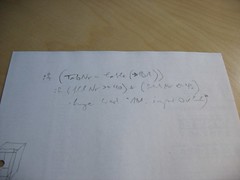On the right use of computers
Friends reported on a public discussion organized by the Architektenkammer about the changes wrought in architecture and design by the use of computers. The meeting came to two at first glance contradictory consensi: that computers either hinder the design process, or are a very useful design tool.
Note however that the terms are not directly opposed: a tool is not a process.
Use of computers has definitely changed the way that design is taught, anecdotal evidence suggests that the computer is now the only design tool used in many schools of architecture. Students these days don't learn to draw by hand*, nor do they build working models as we did: they go directly from the prof's explanation of the project, to the keyboard. There is in my 'umble opinion a very important step missing, which is exactly the process of abstract thought about the meaning and purpose of what you wish to do.
Computers don't do abstract, it's not what they are for. Computers do precise - to fifteen decimal places, by golly, and gawd 'elp you if you actually want -1 places of precision (i.e. to the nearest 10 metres only). Computers tie you down to accuracy too early in the process, when the relative significance of the parts to each other is still undecided. In a pencil sketch, where the thickness of a line equates to a metre or more, it doesn't really matter how large the hallway is or how small the living-room. The sketch says three things: hallway here, living-room there, wall between them. If you do that on the computer, you must place the wall precisely by deciding right now how large those rooms are to be; you must decide how large to make the hallway before you even know where it goes!**
We saw this in our last Praktikant, he could draw anything at all, but he was unable to explain what he'd drawn. It was just lines, they were all correct but he'd drawn them as a mechanical exercise without comprehension. This was very disturbing, because it meant that he wouldn't know when he didn't know something! ("Unknown unknowns" as Donald Rumsfeld rightly said. People laughed, but it was a brilliant and truthful insight.) Every drawing he made, had to be checked by one of us. This is in my opinion directly because he didn't know how to sketch, he hadn't learned this tool of analytical thought.
I myself fall between these positions: I use the computer constantly, in all my work and much of my playtime, but I also sketch and draw by hand constantly. Even in database work, I am always writing notes or diagramming the dataflow to explain it to myself. This is something that a computer cannot do: it can show you how the data does flow, but it can't suggest where it should be flowing. (The three lines on the sketch turned into six new or modified functions totalling well over two hundred lines, by the time I added in error-checking and user feedback.)
* Quote from a panelist: "The courses in life-drawing and painting had to be cancelled, not one single student turned up."
** Yes, of course you can change them later; and the computer is extremely useful as a "getting it right" tool. My point is that the computer's inexorable precision requires you to take decisions with far-reaching consequences very early in the design process. The external hull of the building is determined after you've placed the first two rooms, although you don't yet know how many rooms there will be.





4 Comments:
Toddlers should just go straight to computers, why let them have crayons?
I am definitely a product of the computer generation, but I still need to write things down by hand to help me remember.....lists, how-to, to-do, etc.
Depending on what I'm doing, I sway back in forth on preferring the computer's preciseness or the errors of hand. I get what you're saying, even if I'm not an architect. I think back to doing long, drawn out math probems by hand, using sheet after sheet of paper, and now you can type in the equation directly into calculators/computers and get the right answer without even knowing what it means.
I think this is very true. Computers are unable to create anything 'beautiful' in the sense that beauty always contains an element of imprecision which only the human mind or hand can introduce to the equation - a kind of mutation from the norm, something unpredictable and new, and often accidental - in the sense of a 'happy accident'. People used to show me fractals on their computers and say 'aren't these amazing?', but they left me completely cold because as far as I could see it was just a form of visual number-crunching.
It's a bit early in the day, so maybe I should stop rambling here ....
Post a Comment
<< Home